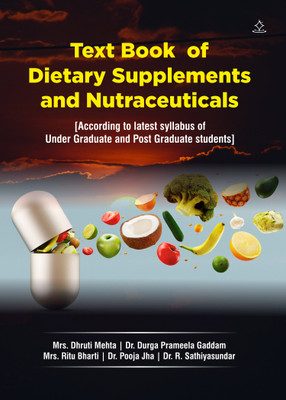TEXT BOOK OF DIETARY SUPPLEMENTS AND NUTRACEUTICALS - According to latest syllabus of Under Graduate and Post Graduate students(Paperback, Mrs. Dhruti Mehta, Dr. Durga Prameela Gaddam, Mrs. Ritu Bharti, Dr. Pooja Jha, Dr. R. Sathiyasundar)
Quick Overview
Product Price Comparison
The Text Book of Dietary Supplements and Nutraceuticals is a comprehensive reference that explores the scientific, clinical, and regulatory dimensions of nutraceuticals and functional foods. It begins with an introduction to nutraceuticals, offering clear definitions of functional foods, dietary supplements, and their classifications, supported with examples. The opening chapter also emphasizes the role of nutraceuticals in preventing and managing health problems such as diabetes, obesity, hypertension, cancer, osteoarthritis, and stress. Public health nutrition, maternal and child nutrition, ageing, and community-based nutrition education are given equal weight, highlighting their relevance to global health. A significant portion of the book is devoted to important natural sources of nutraceuticals such as spirulina, soybean, ginseng, garlic, broccoli, ginkgo, and flaxseeds. For each, the marker compounds, their chemical nature, medicinal uses, and health benefits are described in detail. The text further expands into phytochemicals like carotenoids, sulfides, polyphenolics, flavonoids, phytoestrogens, tocopherols, prebiotics, and probiotics. Their occurrence, characteristic features, chemical properties, and medicinal roles are explained with clarity, linking them to real-world dietary sources such as cereals, vegetables, seafoods, coffee, and tea. The book also introduces free radicals and reactive oxygen species, explaining their generation in cells and the harmful reactions they cause to lipids, proteins, nucleic acids, and carbohydrates. It elaborates on the role of free radicals in diseases like diabetes mellitus, inflammation, ischemic reperfusion injury, atherosclerosis, cancer, kidney and muscle damage, as well as their impact on ageing and brain metabolism. The free radical theory of ageing is explored in depth, connecting it to lifestyle and dietary patterns. Another vital section covers antioxidants. Both endogenous and synthetic antioxidants are presented, including enzymatic defenses such as superoxide dismutase, catalase, and glutathione peroxidase, as well as non-enzymatic antioxidants like vitamin C, vitamin E, ╬▒-lipoic acid, glutathione, and melatonin. Synthetic antioxidants such as BHT and BHA are also included, with discussion on their uses and limitations. This part of the text demonstrates how antioxidants act as a protective shield against oxidative damage, thus preventing chronic diseases. The concept of functional foods is highlighted, with discussions on their applications in chronic disease prevention and how processing, storage, and environmental factors influence their nutraceutical potential. Food safety receives special attention with detailed regulatory frameworks including FSSAI, FDA, FPO, MPO, AGMARK, HACCP, and GMPs, providing readers with a clear picture of quality and safety assurance in dietary supplements.

